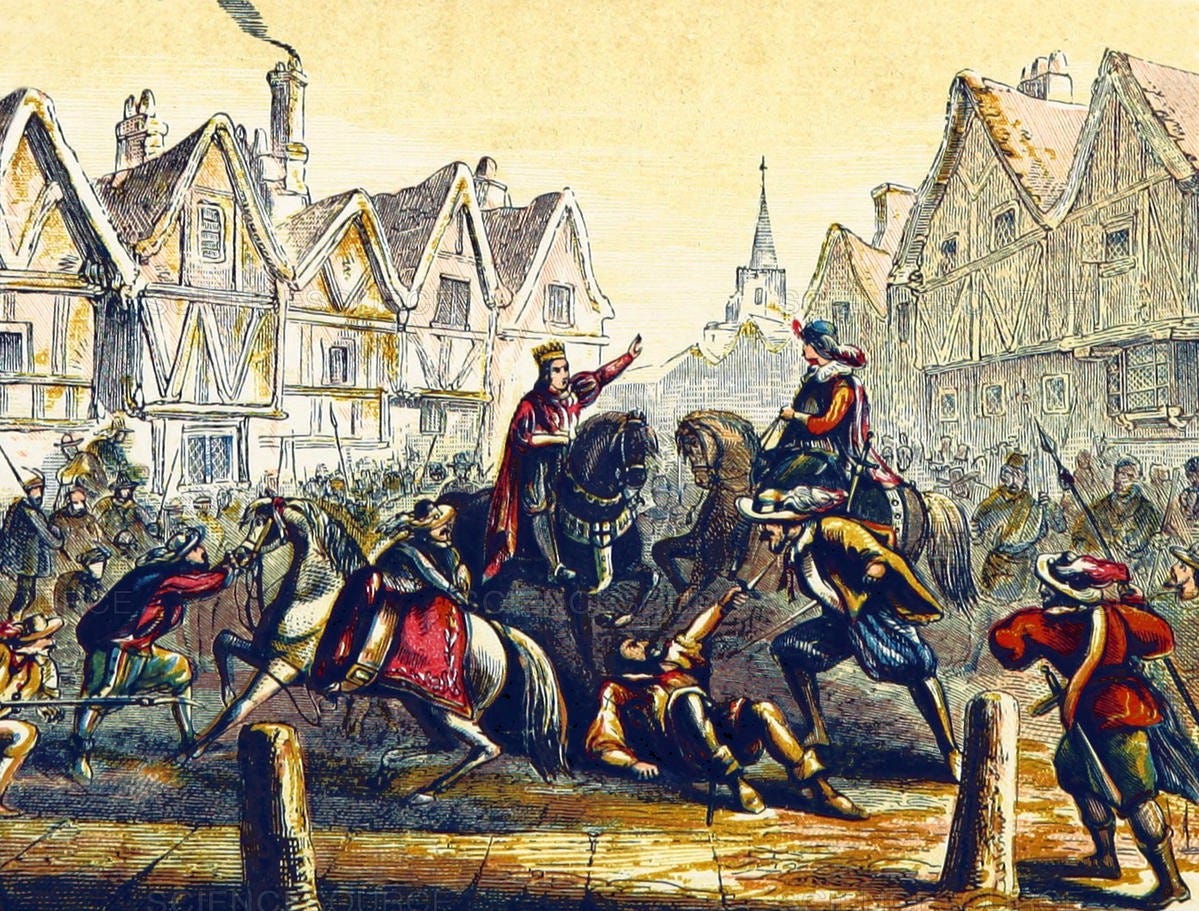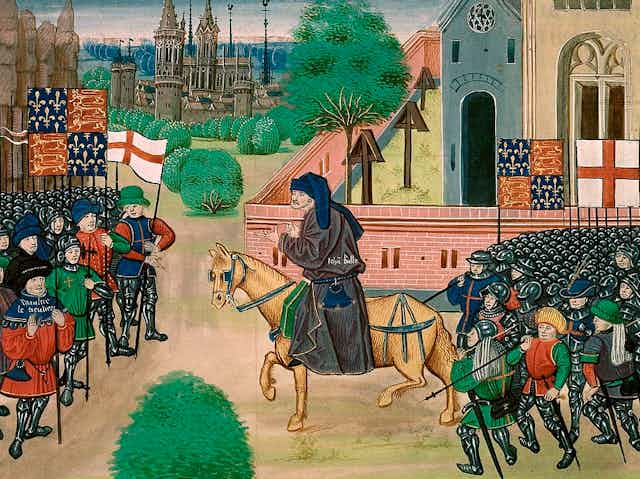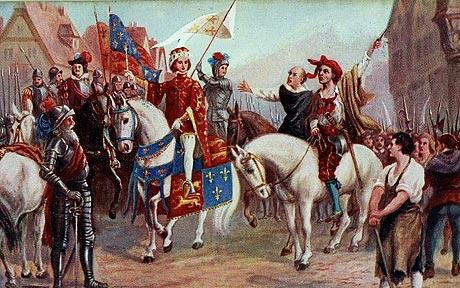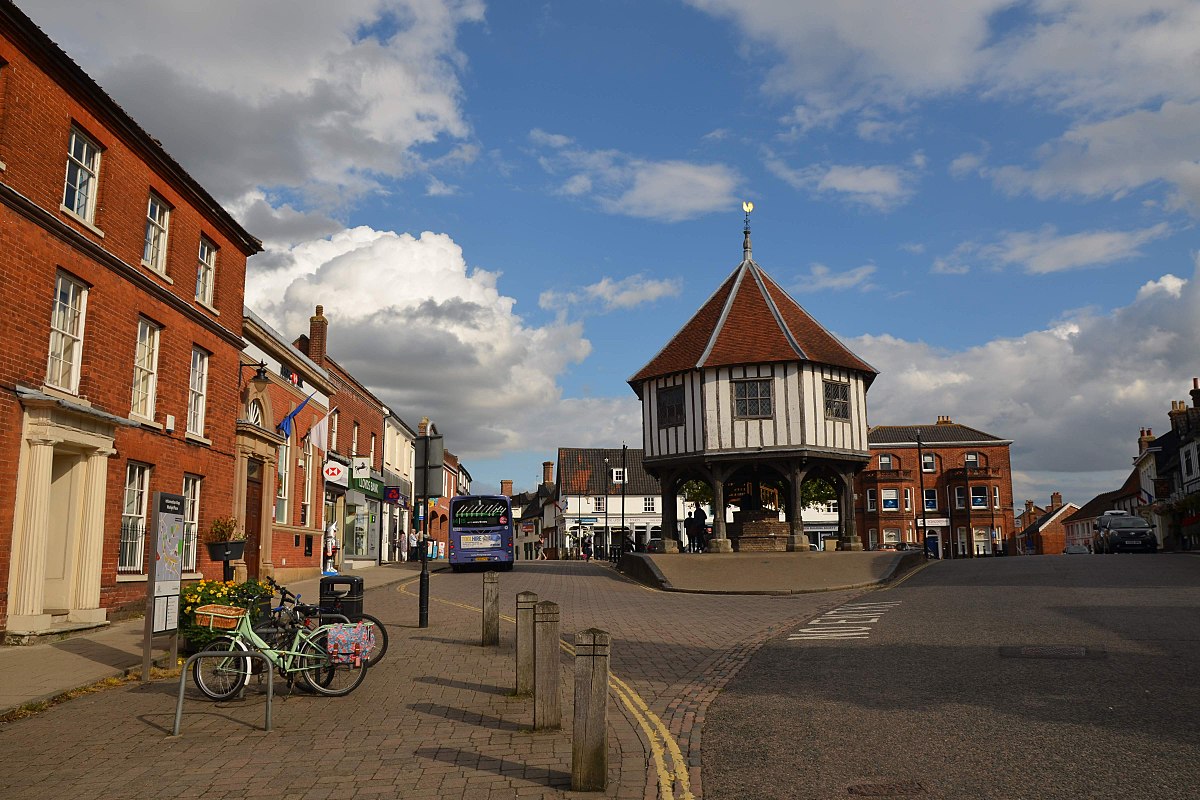As a note for the future, many chapters will be written from the vague perspective of its main characters. A chapter mostly about Richard will mostly be from his perspective, same for Wat Tyler or John of Gaunt.
Without further ado...
Chapter 2 – With the True Commons
June – July 1381
"...that there by no villeins nor gentlemen, but that we may all be united together and that the Lords be no greater masters than we be..."
– John Ball
The Revolt had gone far better than ever imagined. They had smashed their way into London, begun righting the wrongs of those who would undermine the peoples' liberties and even made their way to their King. He had even agreed to negotiate with them on their demands, what could possibly be better? Richard, for his part, did not quite see things the same way. A great mob had marched into the capital of his Realm and sacked half of it to the ground. Yet they claimed to be acting out of loyalty to him? Was he even safe surrounded by these men? Hailes and Sudbury hadn't been. Whoever was right, the situation was where it was, and King Richard did indeed agree to negotiate with the rebels.
The rebels had many requests for the King: abolition of unfree labour, amnesty for themselves and "that there should be no law within the realm save the law of Winchester [1]". Without many other options, Richard agreed to most of their demands, signing charters abolishing feudalism - charters which were quickly spread throughout England - and granting the rebels a general amnesty. Richard was reluctant to hand over his officials, instead personally promising to exact justice himself, although since he was in the same enclosed space as the rebels, he could do little but agree. As the details were announced, the crowd outside roared with cheers and cries of "May God save our good King Richard [2]", at this time it did not put the young King at ease. Tyler at point was ready to return home. He'd gotten almost all of his and the rebels' original demands. But not everyone agreed, some wished for more stringent promises lest Richard be influenced to undo what had just been done.
What happened next is unclear. Whilst in the tower's foreground discussing next moves, an argument broke out between the revolt's captains and some royal officials. The Mayor of London William Walworth made moves to strike Tyler down but he was ultimately stopped as half of his lower right arm was severed clean off by a sword blow from a old Kentish soldier not long back from France [3]. The Mayor would die soon after before the Tyler could have him executed. Furious at the attempt on his life, Tyler ordered the Tower's garrison be purged. Several more officials would be beheaded, including John of Gaunt physician, William Appleton, and Tower of London garrison would be thoroughly purged and replaced by Tyler's own Kentishmen. Among those left alone by the rebels included Gaunt's son Henry Bolingbroke and the King's mother and sister. By the 15th of June, London was now under firm rebel control. From here-on-in, their story became ever intertwined with that of the King.
Outside of London, news of the revolt had spread quickly. Wrawe's men in Suffolk had many successes. Local militias were not raised and major fortifications fell with ease. On the 12th of June, Wrawe's men stormed the abbey at Bury St Edmunds, finding and beheading the Prior, John Cambridge, two days later. The Prior had been widely disliked in the town. Another prominent royal judge, John Cavendish, was found and killed in Lakenheath. In Ipswich, an independent revolt led by Thomas Sampson and John Battisford took the town and looted the Archdeacon's and other tax officials' properties. In St Albans, the townsfolk led by local landowner William Grindecobbe - with Wat Tyler's explicit support - destroyed the town's Abbey, climaxing a long-running dispute between the town and the Abbey. On the 15th, the day Tyler nearly died in London, Cambridgeshire also rose in revolt. The main target of their anger was the University, which was burned down to the tune of "Away with the learning of clerks, away with it! [4]". The Cambridgeshire revolt was led not just by commoners, but also by members of the local gentry such as Geoffrey Cobbe and John Hanchach, showing that the revolt was not just another riot by the peasants about taxation but something far greater in scope and ambition.
Elements of nobility were also involved in the rebellion in Norfolk, led by the weaver Geoffrey Lister and minor lord Sir Roger Bacon. On the 17th, Lister's men stormed Norwich and killed Sir Robert Salle, who had tried unsuccessfully to negotiate with the mob. Back down in Bury St Edmunds, something more unexpected was taking place. William Ufford, 2nd Earl of Suffolk was eating dinner when taken by surprise by Lister's rebels. Lister wished for Ufford to join the rising and led it legitimacy. It was a smart move, but Suffolk refused. Dejected, Lister went looking for other powerful men to support him. At this point, Ufford made his escape by trying to disguise himself as a groom. This effort failed when Ufford and his small escort were intercepted and brought back to the town. Fearing his life, Ufford agreed to support Lister and Bacon, opening his lands for supplying and equipping the rebels such as his castle at Mettingham [5]. Other members of the local gentry were forced to play ball as well, with Ufford serving as something of a calming influence upon the ambitious and headstrong Lister as the unlikely trio of Lister, Bacon and now Ufford set up their headquarters in Norwich [6]. In the region, they would face immediate conflict with the powerful Bishop of Norwich, Henry Despencer.
Setting out from the town of Stamford with a small retainer, Despencer headed out to reclaim Norwich from the rebels. Via Huntingdon and Ely he reclaimed Cambridge. Along the way, his army grew in size until he had roughly 4,500 men under arms, and headed for Norwich to catch the rebel leaders. Lister received word of Despencer's army and assembled a local militia of his own as well as a number of men formally from Ufford's retainer and set out to meet Despencer's men, meeting them at the market town of Wymondham on the 23rd of June.
The Battle of Wymondham, fought on the 23rd of June 1381, was a close-run affair. Lister's men met Despencer's on a field outside the town's Abbey. Despencer himself fought incredibly fiercely, engaging the rebel armies in hand-to-hand combat in their entrenched positions. As this was going on, Ufford waited with his men and a few horses in a treeline watching the battle. Despite having promised loyalty to Lister's cause, he was a prudent man more pone to conciliation than combat. At Wymondham, he was waiting to see which way the wind would blow before coming down on the winning side [7]. After roughly fifteen minutes of fighting, Despencer was struck by a blow to his shoulder and fell to the ground. His aggressive policy and warlike fighting style had not helped him here. Witnessing Despencer's fall from the treeline, Ufford finally made his decision and charged decisively against the Bishop's remaining forces. By the late afternoon, Lister and Ufford had won the day and over 1,800 men from both sides had perished on the field of Wymondham. With the death of Bishop Despencer came the end of his efforts to suppress the uprising, leaving East Anglia in the hands of the revolters.
Further north, the town of Beverley broke into revolt as the local administration was replaced with a new rebel-run one. Unlike the comparatively bloody exchanges in the south and east of England, the North was somewhat calmer with reconciliation between rebels and masters arbitrated by the Archbishop of York, Alexander Neville. In Leicester, the local militia was mobilised on the Mayor's orders, waiting for a rebel army they believed was approaching from Lincolnshire. From his holdout, John of Gaunt placed his Welsh and Yorkshire castles on alert for revolting armies. News of the revolt and the King's charters reached York on the 17th, and the city erupted into violence as Dominican and Franciscan institutions were ransacked. Violence would continue for several weeks. On the 24th of June, John de Gisbourne would force his way into the city with a large mob behind him [8]. As violence raged in the streets, the Archibishop again appealed for calm whilst the Mayor, Simon de Quixlay, attempted to maintain control. Eventually, both sides agreed to let Archbishop Neville to arbitrate, resulting in a new city administration still headed by Mayor Quixlay but granting the rebels their concessions from the King's charters. Archbishop Neville held a sermon in York Cathedral the next day, attended by both warring sides and sealing their agreement with a kiss of peace. Had York been 100 miles closer to the Thames, the Archbishop would almost certainly have been beheaded. It appeared that the northern revolt was over, save for John of Gaunt's castles which were still besieged by rebels, and would fall within a few months starting his hunting lodge in Harrogate on the 2nd of July. As his Yorkshire possessions fell and their armouries seized, his castles in Wales would continue to hold out. As for Gaunt himself, he had fled to Scotland both fearing for his life and also deeply worried for the wellbeing of his son Henry.
Rebels in Somerset secured concessions from the Augustine order in Bridgwater by the 19th, Adam Brugge and Thomas Ingleby extracting from the monastic master the loss of his local privileges. Ilchester prison was also stormed [9].
Back in London, Tyler had realised that in order to protect their cause, the rebel armies would have to fight. The King may have signed charters, guaranteeing his subjects' liberties. Yet there were still those who would not recognise his charters. And the hated John of Gaunt had fled England for the court of Robert II of Scotland. With the King at their side (somewhat), Tyler, Straw and their lieutenants would have to raise an army and march north.
Footnotes
- [1] All demands from OTL. There is debate as to what "law of Winchester" means with debate between the 1086 Domesday Book or the 1285 Statute of Winchester. Seeing as the latter was more commonly referenced at the time, I'm going to assume its refers to the latter Statute which allowed for local self-governance and organisation - a cause the rebels of 1381 were fighting for.
- [2] I don't know if the rebels cheered this or anything similar in OTL, but it's quite fitting so I put it in.
- [3] Inspired by Mumby's "Law of Winchester" timeline.
- [4] So far everything in East Anglia also happened in OTL. The butterflies haven't yet reached this far north.
- [5] A similar event happened in OTL although Ufford was able to escape to London and return once Bishop Despencer had done most of the work suppressing the revolt.
- [6] Ufford was well-known for his moderation and concilliatory approach, something that Lister (who forced the captured gentry to reenact a royal household around him in OTL) would definitely need. In OTL, Ufford died in early 1382 after falling some stairs in Westminster.
- [7] Ufford's actions here are inspired by what Lord Stanley did at the Battle of Bosworth in OTL. The rest of the battle is inspired by the OTL Battle of North Walsham.
- [8] De Gisbourne would attempt to storm York on the 1st of July. Here, the butterflies have moved it up by about a week.
- [9] As occurred in OTL.
Sources
Blood of Kent, by Harold Middlemore (University of Maidstone, 1972) Of course, the seeds of victory for the peasants was laid not in London, or even later in Warwickshire, but in Kent. And the man who truly turned the peasants from a rabble of angry farmers primarily concerned with their taxes...
www.alternatehistory.com

en.wikipedia.org

en.wikipedia.org

en.wikipedia.org

en.wikipedia.org








